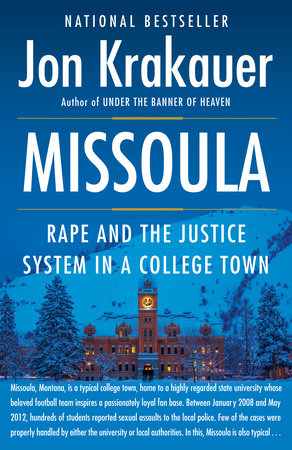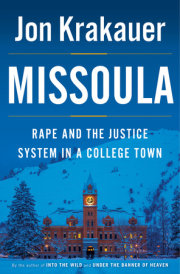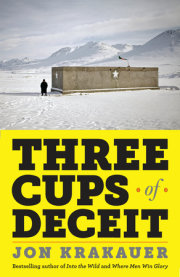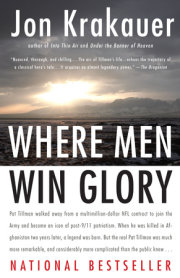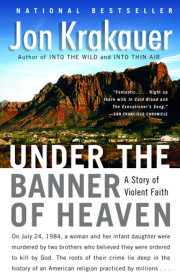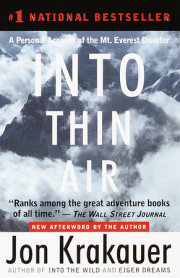Chapter One
Office Solutions & Services, a Missoula office-products company, didn’t have its 2011 Christmas party until January 6, 2012. As a counterpoint to the chilly Montana evening, the staff decorated the place in a Hawaiian motif. Around 9:00 p.m., thirty or forty people—employees and their families, mostly—were chatting, playing party games, and sipping beverages from red plastic cups in a room overlooking the parking lot when a shiny Chrysler 300 sedan pulled up and rolled to a stop in front of the floor-to-ceiling windows, attracting the attention of the revelers. Two well-dressed men with dour expressions got out of the vehicle and stood beside it. “It was a really nice black car,” recalls Kevin Huguet, the owner of Office Solutions.
As he was admiring the Chrysler, one of Huguet’s salesmen asked, “Who are those guys?”
Huguet had no idea. So he walked outside and asked, “Can I help you?”
“We’re Missoula police detectives,” the man who had been driving the car replied. “I just need to talk to Allison.”
“Allison is my daughter,” Huguet said, his hackles rising. “You’re going to have to tell me a little more than that.”
“Dad, it’s okay,” twenty-two-year-old Allison Huguet interjected, having walked out to the parking lot shortly after her father.
Detective Guy Baker, who is six foot five and weighs 250 pounds, peered down at Allison, a slender woman with bright eyes and a ponytail. “I need to talk to you,” he said. “We don’t have to do this in front of your dad. How do you want us to handle this?” He and Allison walked away from the car to speak privately, while Detective Mark Blood remained behind with Kevin Huguet.
“Hey,” Baker said to Allison in a warmer voice when they’d moved a short distance away. They’d become acquainted four years earlier, during her final year of high school, when she asked him to serve as her mentor for a school project. It had been a positive experience for both of them. Explaining why he’d shown up during the company Christmas party, he said, “I thought it was important to tell you in person as soon as possible: About an hour ago I arrested Beau Donaldson. I got a full confession from him, and he is in jail.”
Allison’s eyes brimmed with tears of relief.
Over by the Chrysler, Kevin Huguet grew impatient as he watched Allison and Baker conferring. “You know what?” he told Detective Blood after a few minutes. “I want to know what’s going on here. This is my daughter, and I want to know what’s going on.” Kevin abruptly strode away and confronted Baker.
“She didn’t do anything bad,” Baker said. “It’s not like that.” Then Baker turned to Allison and said, “I think you really need to talk to your dad and tell him.”
Allison faced her father and, in a shaky voice, declared, “Beau raped me.”
Kevin stood on the cold pavement, gobsmacked. Struggling to make sense of the words his daughter had just spoken, he wrapped his arms around her. As he hugged Allison and began to process what Beau Donaldson had done to her, Kevin’s shock and confusion turned into blinding rage.
“I thought he was going to find Beau and kill him or something,” Allison told me, recalling the events of that night.
Beau Donaldson, a junior at the University of Montana at the time of the assault, was on the school’s football team. Allison Huguet was attending Eastern Oregon University on a track scholarship. They had grown up together in Missoula and had been inseparable friends since the first grade, but the relationship had never been romantic.
Donaldson often referred to Huguet as his “little sister,” and the sentiment was reciprocated. Throughout her childhood and adolescence, Huguet regarded Donaldson as the brother she never had. For the previous sixteen years, Huguet’s parents had welcomed Donaldson into their home as if he were a member of their family. “You spend your whole life, when you have kids, protecting them,” Kevin Huguet told me. “But who thinks their daughter’s trusted friend is actually a monster who is going to hurt them in the night?”
Allison was as angry as her father, but a confounding mix of other emotions had supplanted her rage. Donaldson raped her on September 25, 2010. She had waited fifteen months, suffering in silence, before going to the police. During that period she told nobody beyond her mother and three or four close friends that she had been raped—not even her father or sisters knew about it. Such reticence, it turns out, is common among victims of sexual assault. No more than 20 percent of rapes are reported to the police, a statistic that defies comprehension until one looks closely at how sexual-assault cases are adjudicated in the United States.
Montana is a huge place with relatively few people. Although Missoula is the state’s second largest city, it only has seventy thousand residents. Congenial and picturesque, it’s the kind of community that charms first-time visitors into putting money down on real estate within hours of arriving. Some 42 percent of the population has a bachelor’s degree or higher, compared to 28 percent of the rest of the nation. Good restaurants and lively bars abound. A legendary trout stream, the Clark Fork, runs fast and clear through the heart of downtown, paralleled by an abandoned railroad right-of-way that’s been transformed into a bucolic thoroughfare for cyclists, joggers, and strollers. South of the river, the city’s unpresuming neighborhoods stretch across a broad valley, above which five mountain ranges converge.
From Missoula’s origins in the mid-nineteenth century until the late decades of the twentieth, the local economy depended heavily on timber cut from the surrounding high country. About thirty-five years ago, however, the forest-products industry began to fall on hard times. Most of the sawmills closed, and loggers in calk boots and tin pants became an endangered species. A behemoth pulp mill pumped $45 million annually into the local economy (and at times created a noxious smog that settled so densely over the city that drivers had to turn on their headlights in the middle of the day) until 2009, when it was shuttered and sold for scrap.
Presently the largest employer in the Missoula Valley is the University of Montana, by a large margin. With its 15,000 students and more than 800 faculty members, UM, as it is known, has left a deep imprint on the city. Missoula has a much higher proportion of Democrats, for instance, than the state as a whole. As locals like to joke, one of the things that’s so great about living in Missoula is that it’s only twenty minutes from Montana.
Despite its liberal bent, in many ways Missoula resembles other cities of similar size in the Rocky Mountain region. Its population is 92 percent white, 2 percent Native American, 2 percent Hispanic, and less than 1 percent African American. The median family income is $42,000. Twenty percent of the population lives below the poverty line. Among Missoulians there is strong support for the right to keep and bear arms, and for limiting the role of the federal government in their affairs.
Missoula has a culture uniquely its own, however, thanks to the fusion of its gritty frontier heritage with the university’s myriad impacts. UM has nationally distinguished programs in biology and ecology and is perhaps even more renowned for its literary bona fides. The faculty of the university’s Creative Writing Program, founded in 1920, has included such influential authors as Richard Hugo, James Crumley, and William Kittredge. Reminiscing in one of his incomparable essays about what drew him to Missoula for the first time, Kittredge wrote,
I was looking for what I took to be a genuine world to inhabit. I wanted to be someone that I could understand and stand—a romantic idea that seems commonplace in the West these days. . . . The northern Rockies seemed like an undiscovered land, thick with secrets no one could bother to keep.
During a drunken visit to Missoula to go fishing with Kittredge in 1972, Raymond Carver, the godfather of minimalist fiction, fell head-over-heels in love with both the town and Diane Cecily, the university’s director of publications. Richard Ford, the Pulitzer Prize–winning novelist, resided in Missoula for three or four very productive years in the 1980s and is recalled with pride by its citizenry. The literary figure most closely identified with the town, however, is Norman Maclean, the author of A River Runs Through It, the semiautobiographical work of fiction set in Missoula and on the nearby Big Blackfoot River, from which the Academy Award–winning film starring Brad Pitt was adapted.
But never mind Kittredge or Ford or the Big Blackfoot. Missoulians’ greatest source of civic pride, hands down, is the University of Montana football team, the beloved Grizzlies of the Big Sky Conference, who won the Football Championship Subdivision national title in 1995 and 2001. Their record of twelve straight conference titles prior to 2010 was the second-longest streak in NCAA Division I history. In 1985, a billionaire Missoula construction magnate named Dennis Washington donated $1 million to build Washington-Grizzly Stadium, a beautiful facility that seats 25,200 and is filled to capacity for almost every home game. The Grizzlies’ overall record from the opening of the stadium through 2011 was a remarkable 174 wins and 24 losses.
The Griz don’t play at the same elite level as college-football colossi like Florida State, Ohio State, and Alabama. It’s fair to say that the team’s win-loss record would be much less impressive if they played under the bright lights of the Big Ten or the Southeastern Conference, instead of in a backwater like the Big Sky. Be that as it may, the Grizzlies inspire the same kind of fanaticism in Missoula as the Seminoles do in Tallahassee and the Crimson Tide does in Tuscaloosa. UM fans call themselves “Griz Nation.” Missoula is “Grizzlyville.” It would be hard to overstate the degree to which Griz football is exalted by the residents of western Montana.
Recent events, however, have forced at least some Missoulians to reconsider their veneration of all things Griz. In December 2010, four of Beau Donaldson’s teammates on the UM football team allegedly gang-raped a female student when she was too drunk to resist, and because the football players claimed the sex was consensual, they were not charged with a crime. A year later, in December 2011, three Griz football players sexually assaulted two female students after allegedly drugging them. None of these assailants was prosecuted, either.
When the latter incident was brought to light by the local newspaper, UM president Royce Engstrom appointed the Honorable Diane Barz, who in 1989 became the first woman to serve on the Montana Supreme Court, to launch an investigation. In a preliminary report, released to the public on December 31, 2011, Barz wrote,
This investigation has revealed . . . evidence of non-consensual sex that is not being reported in the University system. . . . The University is required to take immediate and appropriate action.
In Barz’s final report, completed on January 31, 2012, she identified nine sexual assaults by UM students (not all of whom were football players) from September 2010 through December 2011. At the top of the list was the rape of Allison Huguet by Beau Donaldson. Barz warned,
The reports of sexual assaults on the UM campus now require immediate action and swift compliance with Title IX mandates. . . . A rape-tolerant campus with ineffective programming, inadequate support service for victim survivors, and inequitable grievance procedures threatens every student. . . . Acts of sexual violence are vastly under-reported on college campuses and a victim of sexual assault is likely to suffer from depression, post-traumatic stress disorder, substance abuse, and academic problems.
Diane Barz’s report rattled Missoula. Then, just three months later, the U.S. Department of Justice revealed that it, too, was investigating the apparent epidemic of sexual assaults in western Montana. The feds announced that at least eighty alleged rapes had been reported in Missoula over the preceding three years and that the DOJ would be scrutinizing “assaults against all women in Missoula, not just university students.”
United States attorney general Eric Holder noted, “The allegations that the University of Montana, the local police department and the County Attorney’s Office failed to adequately address sexual assault are very disturbing.”
The spate of rapes in Grizzlyville led to disquieting articles from such national publications as the New York Times and the Wall Street Journal. But it was a 3,800-word dispatch posted on the website Jezebel nine days after the DOJ announcement that perhaps did the most damage to Missoula’s good name. Written by Katie J. M. Baker, it was titled “My Weekend in America’s So-Called ‘Rape Capital,’ ” and the derogatory moniker went viral, prompting an outcry from Missoulians who believed it was unfair.
Baker’s tart, insightful piece indicated that she wasn’t sure the description was deserved, however. Her headline was drawn from the article’s second paragraph, in which she quoted a twenty-year-old Missoula drug dealer who lamented, “People think we’re the ‘rape capital’ of America now,” before immediately noting, “but we’re not. Missoula is just like any other college town.”
In fact, 80 rapes over the course of three years appears to be “on par with national averages for college towns of Missoula’s size,” as Baker mentioned in her piece. According to the FBI’s latest statistics, there were an average of 26.8 “forcible rapes” reported in American cities the size of Missoula in 2012—which works out to be 80.4 rapes over three years. In other words, the number of sexual assaults in Missoula might sound alarming, but if the FBI figures are accurate, it’s actually commonplace. Rape, it turns out, occurs with appalling frequency throughout the United States.
Chapter Two
When Allison Huguet was five years old, her family moved from Kalispell, up near Glacier National Park, to Missoula, where they bought a home in a quiet neighborhood called Target Range, at the western edge of the city, near the confluence of the Bitterroot River and the Clark Fork. Huguet enrolled in the first grade at Target Range School and soon befriended Beau Donaldson. They remained close buddies for the next twelve years.
Huguet and Donaldson graduated together in June 2008 from Big Sky High School, where both of them were good students and outstanding athletes. Huguet, who competed on the track team, was the Montana pole-vault champion their senior year. Donaldson set ten school records on the football field and was honored as the team’s most valuable player. When Donaldson accepted a scholarship to play football at UM, it was deemed sufficiently important to merit an article in the Missoulian, the local newspaper. “I’ve always wanted to play for the Griz,” Donaldson told the paper. He had been recruited by a number of other schools, including Montana State University, in Bozeman, the archrival of the University of Montana. It was a big deal in Missoula when he decided to attend UM.
Copyright © 2015 by Jon Krakauer. All rights reserved. No part of this excerpt may be reproduced or reprinted without permission in writing from the publisher.





